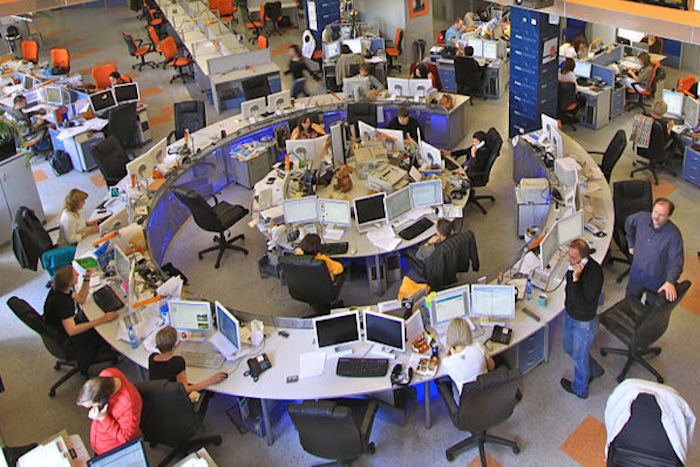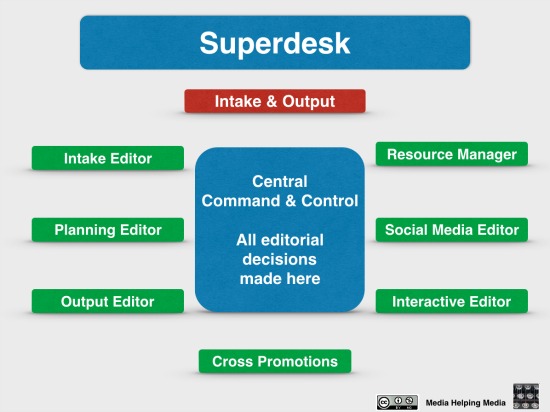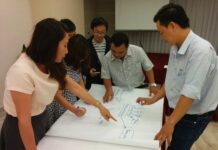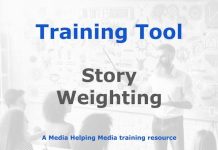
A converged newsroom operates like a ‘content factory’, with a centralised ‘command and control’ desk responsible for all news intake, production and output.
It gathers and processes raw material, creates different products, and then ensures they are delivered to the target audience. In this module we look at how it is done.
This module is about the workflows and roles and responsibilities that make a converged newsroom run smoothly. You might want to read our article on the strategic thinking behind newsroom convergence.
Central to the whole operation is that ‘command and control’ area, often called a ‘superdesk’ or ‘news hub’. The name you give it doesn’t matter as long as it performs the role of centralising all operations.
Below is a graphic setting out what a typical superdesk might look like.

The superdesk
- Both intake (everything that comes into the news operation), and output (everything that is delivered from the news operation to the audience on multiple devices) need to be close together.
- Ideally, representatives of both will sit around the same desk.
- If space is an issue, and one desk can’t be set up, then they need to be sitting close together.
- They need to be able to communicate and collaborate at all times in order to respond swiftly to changes in news priorities.
People give this desk different names. Some call it the news hub, some the news cog; it doesn’t matter what it’s called, what matters is what it does. For this series of training modules we are calling this desk the superdesk.
- The superdesk is the newsroom’s central command-and-control.
- It’s where all the main news decisions are made.
- It serves as a responsive, dynamic focal point for everything to do with the smooth running of the news organisation.
Seats at the superdesk
- Those sitting around the super desk need to be breathing the same air, hearing the same news alerts, and be taking part in impromptu news meetings, called to deal with the unexpected.
- Choosing who sits at the superdesk is up to you. That decision will depend on your overall strategy and who the main decision makers are in your news organisation.
- It will also depend on where you need to prioritise effort, the most popular platforms/devices used by your target audience, and the resources available to you.
- However, there are a number of important roles that should be represented on the superdesk.
- These are roles, not necessarily individuals.
- For example, the intake editor role will probably need to be covered 24 hours a day for a large news organisation. In that case, the intake editor position on the superdesk should be a seat, populated by different people as working shifts change.
- The exceptions might be the planning editor and the cross-promotions roles. They might be positions that need to be filled during the daytime only.
- Intake editor role: This is the person who is responsible for everything coming into the building.
- Output editor role: This is the person who provide the quality control for everything going out of the building and who liaises directly with production.
- Interactive editor role: You will need someone from the interactive team. They need to ensure the website and all digital platforms are publishing all breaking and developing news updates. They will also report to the superdesk regarding all developments on social media.
- Resource manager role: You will need someone to manage resources, and someone representing planning.
There are other roles you could add, but let’s start with the main ones.
The intake editor
- The intake editor acts as the eyes and ears of your news business.
- They are responsible for all the material that comes into your news production process.
- This will include the news gathering efforts of your own team of journalists.
- It will involve responding to stories that are being fed by wires services.
- It will involve monitoring the stories being covered by the competition.
- The intake editor has the authority to call an instant, stand-up impromptu meeting when there is breaking news, in order to help the output team adjust to new developments.
- They are, essentially, looking out of the building at all the elements that will inform and feed your news operation.
- They are not responsible for output. This is an important point. That role falls to the output editor.
The output editor
- The output editor looks after quality control.
- They are also responsible for ensuring deadlines are met.
- They are the defender of the news brand.
- Nothing gets past the output editor that could damage that brand.
- They ensure the material is accurate, that it’s objective, impartial and fair.
- Their job is to focus on production values.
- They need to ensure all platforms are served.
- They can’t afford to be distracted by watching the competition, keeping up to date with the wires services, and responding to input issues and logistics.
- That’s why those tasks are the responsibility of the intake editor.
- However, the two work closely together, although doing different jobs.
- They are in constant communication.
- Between them the main news decisions for the whole news operation rest.
Planning editor
- We discussed the strategic role of the planning editor in the module about forward planning.
- The planning editor is responsible for managing the news organisation’s unique editorial proposition of in-depth, well-planned, investigative journalism, which provides your market differential.
- The planning editor will attend all the main news meetings held at the superdesk.
- They will offer at least one piece of original journalism a day, probably more than that.
- They will listen to what is happening on the day and will ensure that all the major stories are followed up. The shared planning calendar will help.
- The planning editors role will not only take the pressure off the journalists working on the daily output, but it will also guarantee that there is a continuous stream of unique content produced on all platforms.
Interactive editor
- Having someone from the interactive team sitting on the superdesk means that the online and mobile coverage will be able to respond faster to breaking news developments.
- It also means that the superdesk will be informed about how the audience is responding to developing news, and it will provide a different perspective on newsgathering and how news should be covered.
- Similarly, having someone from the social media team, will alert the superdesk to developments on the various social media platforms used by the target audience.
- This will ensure that the online and other digital versions of your output are not just an after thought but are a central part of all you do.
- And that will show through in your production values, which, in turn, might encourage the audience to engage with your content more.
- This will also help with cross-promotion because your on air presenters can be briefed to drive audience traffic to the online and on mobile versions for any added value content.
Resource manager
- This role is sometimes called the production manager.
- This is the person who is responsible for all the resources required to produce the journalism.
- This could be the camera crews, the vehicles, and the edit suites.
- The resource manager needs to respond quickly once the intake editor has alerted the superdesk of a new story development, and the editorial team on the superdesk decides that information is so important that resources have to be shifted from a lesser story.
Cross-promotions producer
- Some newsrooms have a cross-promotions producer.
- Their job is to ensure that all output areas are aware of what others are doing and that content is exploited for the maximum benefit of the news brand and the audience.
- They will work across TV, radio, print, online and mobile where appropriate.
- In some cases they will design teasers, in other cases they will make sure the material is produced by others.
- Essentially, they will ensure there are no wasted opportunities.
Next we look at the workflow for a converged newsroom.
Converged newsroom workflow
The roles and responsibilities outlined above are just a guide. You will need to design your own version of a superdesk so that it makes business sense for your media organisation.
But do try to keep intake and output as separate roles. And do ensure that you have a planning function. Once you have reorganised, the workflow is fairly simple.
As has already been stated, the superdesk is your newsroom’s central command-and-control. All the main news decisions are made here. It is responsible for intake, planning and output.
As you will see from the graphic below, once those decision are made the instructions are sent to production – ideally via a representative attending the superdesk meetings.

The production teams then ensure that the appropriate platform-specific value is added to the story based on audience needs, device/platform capabilities, and strategic business logic.
That means that if they are working on the web or mobile versions they will add interactive timelines, infographics, photo galleries, video, and other digital assets, where appropriate.
If they are working on the TV version they will create TV packages that can cross-promote the digital assets being offered on the other platforms.
Production will no longer be carried out in isolation but as a part of a coherent and coordinated presentation on multiple devices.

Questions
- What is the primary function of a converged newsroom?
- Describe the role of the superdesk in a converged newsroom.
- Identify and explain the responsibilities of the intake editor.
- What are the key duties of the output editor, and how do they differ from those of the intake editor?
- How does the planning editor contribute to the newsroom’s operations?
- Discuss the importance of having an interactive editor at the superdesk.
- Explain the role of the resource manager in the context of a converged newsroom.
- What is the purpose of a cross-promotions producer, and how do they enhance the news brand?
- Analyse how the workflow of a converged newsroom ensures effective news production across multiple platforms.
- Evaluate the significance of keeping intake and output as separate roles within a converged newsroom.
Answers
- A converged newsroom functions as a content factory, responsible for the intake, production, and output of news content.
- The superdesk serves as the central command-and-control point in a newsroom, where all main news decisions are made and where intake and output are closely coordinated.
- The intake editor is responsible for all incoming material, including news from journalists, wire services, and competitors. They can call impromptu meetings for breaking news.
- The output editor ensures quality control, meeting deadlines, and maintaining the news brand’s integrity. Unlike the intake editor, they focus on production values and output rather than incoming news.
- The planning editor manages the newsroom’s editorial strategy, ensuring a continuous stream of unique content and attending main news meetings to follow up on major stories.
- An interactive editor ensures that online and mobile coverage is responsive to breaking news and provides insights into audience engagement and social media developments.
- The resource manager oversees the resources needed for journalism production, such as camera crews and vehicles, and reallocates them as necessary based on news priorities.
- A cross-promotions producer ensures that all output areas are aware of each other’s activities, maximising content exploitation across various platforms to benefit the news brand.
- The workflow of a converged newsroom involves coordinated production across platforms, adding platform-specific value to stories based on audience needs and strategic logic.
- Keeping intake and output separate allows for specialised focus on gathering and producing news, ensuring efficiency and quality in both areas.
Lesson plan for trainers
If you are a trainer of journalists we have a free lesson plan: ‘Newsroom convergence‘ which you are welcome to download and adapt for your own purposes.









